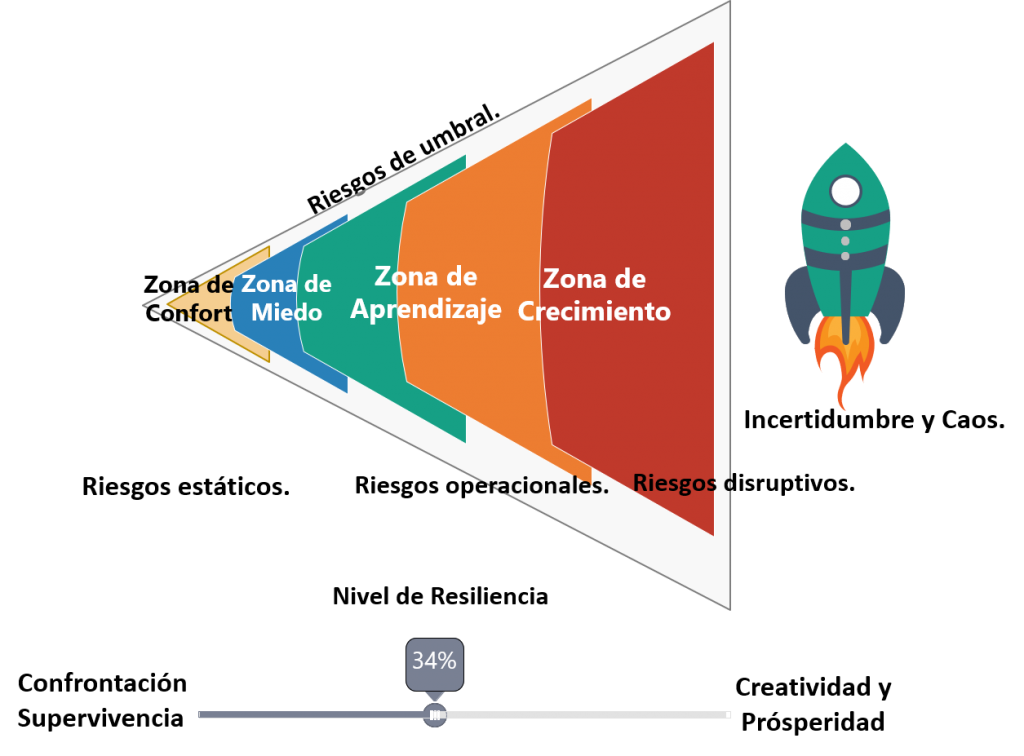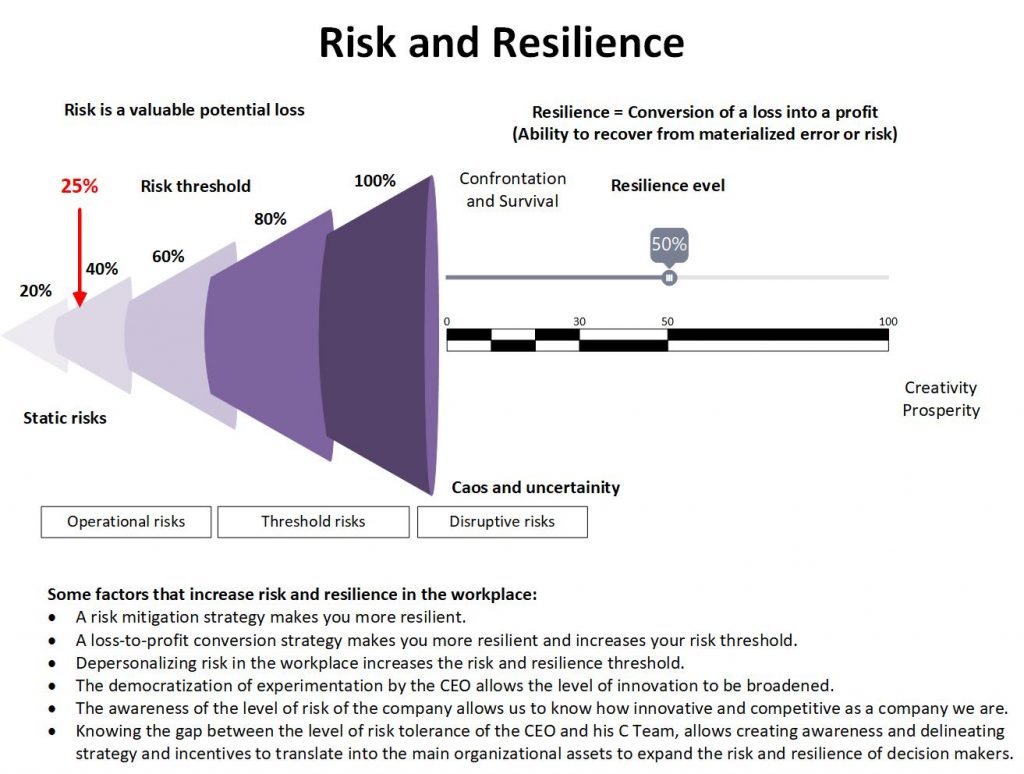In this article we would like to address in a practical way the explanation of a crisis response model with agile and useful to face any other:
The global scenario that we are living today is the following, according to the IOW, 436 million companies in the world are at risk of closing, unfortunately many have already done so, therefore it is necessary to adopt urgent measures to help these businesses and their collaborators.
The image below simplifies the business reality that is being experienced today. According to Gartner we have 3 phases in the impact of a crisis.
- The decline, legislatively established.
- The reopening, with subsidies, market protection and restructuring
- The new normal, when protectionism fades and subsidies are no longer vital.
These 3 phases in turn involve 3 ways of acting respectively:
- Response, immediate actions to keep people and essential business operation, this relatively short period is marked by great effort and potentially chaotic activity. Activities: (1) Temporary solutions to maintain vital business functions.
- Recovery, restart of activities, reopening, rehiring, budgeting, supplying, creating a plan to recover a scalable state, more organized / coordinated effort to stabilize operations. Average duration. Key activities: (1) Create a plan to restore a scalable state. (2) Identify the capabilities you need to harden, refactor, reopen, rehire, refund, and replenish and
- Renewal, strategic, durable execution process throughout the organization. Using lessons learned and emerging patterns from previous phases as elements of a new foundation, the key activities are: (1) Learn to perform operations processes and workflows in new, repeatable, and scalable ways, (2) Use lessons learned and emerging patterns from earlier phases to coalesce around a new foundation and a way forward.
The way the Recovery is approached will have a significant impact on our position in the market, there is a baseline that raises the return to this new normal. Below the baseline we will find, the reduction of operations and below the withdrawal from the market. In the average or baseline we will have the return, and above this we will have the re-invention and re-escalation or growth.
The decline was framed by 3 key constraints, for most of the businesses:
- Mobility and safety, safety of our employees, restricted mobility by decreeing a healthy distance and closing business operations.
- Face-to-face communication, enabling a way of working that prevents direct contact between collaborators and clients to safeguard their physical and emotional integrity.
- Continuity of operations, identify the priority business processes that allow the continuity of the service, in such a way that all those that can be operated under the 2 previous restrictions were a reality, the base tool is remote work.
The key trends for business recovery have been the following:
- Digital Transformation, enable the infrastructure and automation of business processes that allow a digital operation.
- Remote Work, enable virtual work to provide an operation platform that allows digital interactions of the business, clients and collaborators.
- Agile to maximize value and accelerate recovery, operate agile every day.
Graph 1: Agile and COVID 19.

Source: Miguel Martínez (2020). Based on Gartner (6).
At Exponential Agility we have outlined our own strategy aligned with this approach, we initially published it 6 months ago, the main premises of agile for planning for response, recovery and renewal consist of:
A. ACCEPTING CHANGE AND ACTIONABLE THINKING: (1) Decentralize decision-making, (2) generate alternatives for the benefit of the (3) psychological safety of the environment and (4) business economics.
B. ESTABLISHING A CONTINUOUS, OPEN AND TRANSPARENT COMMUNICATION CHANNEL:(1) Establish teams and feedback loops at all levels, (2) Clarify and manage expectations in these cycles with stakeholders, (3) Define what value is.
C. IDENTIFY AND MEET CRITICAL NEEDS: (1) Not everything is easy to do, nor everything should be done, (2) Decompose and define the situation into manageable pieces, (3) Gain clarity and prioritize attention to needs based on the definition of value.
D. CO-CREATE THE MEANINGFUL SOLUTIONS: (1) Be a facilitator, co-create solutions as hypotheses to be tested (2) Prioritize by defining value and causality, (3) Act with meaning and experiment with hypotheses.
E. DELIVER THE RESULTS IN AN ITERATIVE, INCREMENTAL AND EMERGING WAY: (1) Execution discipline in the feedback of results in the established cycles, (2) Preserve alignment, autonomy to ensure delivery of solutions, (3) Ensure the psychological safety of the environment.
F. PERFORM A JOB INSPECTION AND ADAPTATION: (1) Review and feedback the results according to the established cycles, (2) Adapt the results based on the lessons learned from the target achievement level, (3) Improve or pivot.
Graph 2: Agile Mindset for Attention to a Crisis.

Source: Miguel Martínez (2020). Own Elaboration.
Thus, we must maintain this mental focus to plan the activities of our delivery roadmap, remembering the flow orientation and the short time limits to execute our blogs, after having our agile roadmap that defines how we will deliver our strategy, let’s remember where we want to reach each phase and if that is going to help us reach the next level. We would thus have 5 possible archetypes of scenarios:
Table 1: Possible Positions in the Market.

Source: Gartner (6).
Gartner describes possible post-pandemic pathways as rescale, reinvent, go back, downsize, and retire, although many of those pathways are not straightforward. It is in the renewal phase that wise leaders take the opportunity to reestablish or rebuild their business models and operations for a new reality, regardless of the current state or inertial behavior, the truth is that it is necessary to see it with a new mindset that is what most challenging of all.
Table 2: Phases of attention of a crisis.

Source: Miguel Martínez (2020). Own Elaboration based on Gartner (6).
To gain clarity and conduct future product inspections and adaptations, we will use a product framework and roadmap, using the approach outlined by Roman Peachler at Strategize, to define our vision and strategy.
Graph 3: Product strategy.

Source: Strategize by Roman Pichler (12).
Graph 4: Crisis Response Strategy Framework.

Source: Miguel Martínez (2020). Based on Strategize by Roman Pichler (12).
Graph 5: Exemplary Roadmap.

Source: Mindwires.
Graph 6: Phases of attention to a crisis.

Source: Miguel Martínez (2020). Own Elaboration based on Gartner (6).
Agile is a strategy for the response, recovery and renewal of business, useful to face almost any type of crisis, it allows us to accelerate our digital transformation, combined with remote work and leveraged with the normalization of a new way of working, as a leader Executive of a business, do you expect another crisis to impact your business? We invite you to transform yourself so that this impact is positive and your company enjoys advantages, at Exponential Agility we can help you.
Contact us at: contact@exponentialagility.org
Thank you very much for reading our articles.
Miguel Martínez, October 2020.
Bibliography:
- AG, D. (2020, March 10). Respond and Recover | Crisis management in unprecedented times. Retrieved August 20, 2020, from https://www2.deloitte.com/us/en.html
- Allas, T., Sjatil, P. E., Stern, S., & Windhage, E. (2020, April). How European businesses can position themselves for recovery. Retrieved September 10, 2020, from https://www.mckinsey.com/
- C, B., 2020. Domains Of Business Agility – Business Agility Institute. [online] Business Agility Institute. Available at: <https://businessagility.institute/learn/domains-of-business-agility/> [Accessed 28 September 2020].
- Dreyfus model of skill acquisition. (2020, June 18). Retrieved September 18, 2020, from https://en.wikipedia.org/wiki/Dreyfus_model_of_skill_acquisition
- Harvard business essentials: Crisis management: Master the skills to prevent disasters. (2004). Boston, MA: Harvard Business School Press.
- Howard, C., 2020. Reset Your Business Strategy In COVID-19 Recovery. [online] Gartner.com. Available at: <https://www.gartner.com/smarterwithgartner/reset-your-business-strategy-in-covid-19-recovery/> [Accessed 28 September 2020].
- Mahadevan, D. (2018, February 20). ING’s agile transformation. Retrieved September 19, 2020, from https://www.mckinsey.com/industries/financial-services/our-insights/ings-agile-transformation
- Mitchell, C. (n.d.). The Conference Board – TCB C Suite Challenge 2020 Covid19 Recovery. Retrieved September 10, 2020, from https://conference-board.org/us/
- LEANTALK, 2020. The Ultimate Lean Talk Forum and Blog- About Us. [online] Leantalk.org. Available at: <https://leantalk.org/about-leantalk-org> [Accessed 14 September 2020].
- One, V. (n.d.). 14th Annual State of Agile Report. Retrieved September 10, 2020, from https://stateofagile.com/
- O’rreally, B. (2020, May 11). Scaling Innovation Means Descaling Work. Retrieved September 10, 2020, from https://barryoreilly.com/resources/
- Pichler, R. (2016). Strategize: Product strategy and product roadmap practices for the digital age. Lieu de publication non identifié, DE: Pichler Consulting.
- Saenz, H., Supko, M., & O’Keefe, D. (n.d.). Why Return to “Normal” When You Can Recover to a Winning Position? Retrieved September 10, 2020, from https://www.bain.com/
Read more




















